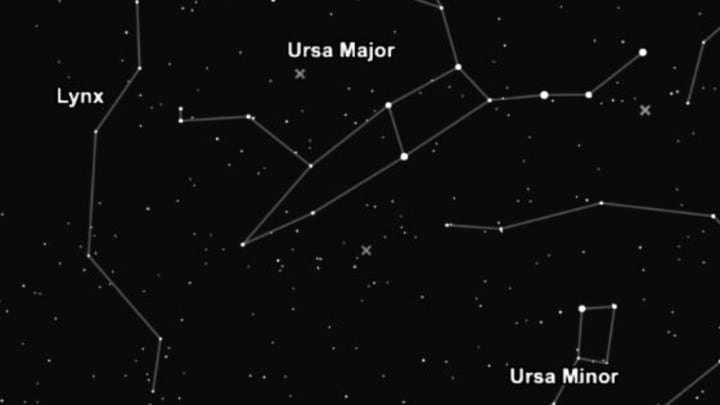
The Ursa Major constellation is the constellation that includes the Big Dipper. So the next time you see the big dipper, you look for the rest of the constellation, and maybe even see the Big Bear shape. Ursa Major is a well-known constellation in many cultures. It is one of the oldest constellations in the sky, and has been referenced several times through out history, including in the Bible.
It's easy to spot the Ursa Major Constellation in the night sky!

All you have to do is find the big dipper, and then look for the extra stars that make the rest of the bear.
“I like the night. Without the dark, we'd never see the stars.” ― Stephenie Meyer

Ursa Major and Ursa Minor Next to their Neighbour Constellation Lynx
The credit to discovering Ursa Major appears to go to an English astronomer Richard A. Proctor in 1869.
Mythology
Ursa Major has several different myths made about it; the constellation has been a wonder to our ancestors.
The Romans called the constellation Septentrio, and saw it as an Ox pulling a wagon.
In Hindu legend, the brightest stars of Ursa Major are known as Saptarshi.
In some First Nation mythologies, it was seen a bear being chased by warriors.
Ursa Major contains seven Messier objects.
- Messier 40 (M40Winnecke 4)
- Messier 81 (M81, NGC 3031, Bode’s Galaxy)
- Messier 82 (M82, NGC 3034, Cigar Galaxy)
- Messier 97 (M97, NGC 3587, Owl Nebula)
- Messier 101 (M101, NGC 5457, Pinwheel Galaxy)
- Messier 108 (M108, NGC 3556)
- Messier 109 (M109, NGC 3992)
Ursa Major also contains 13 stars with confirmed planets.
The brightest star in the constellation is Alioth.
Using Ursa Major for Navigating
The Big Dipper is also very useful in navigation as it points the way to Polaris, the North Star.
The Major Stars in Ursa Major
- Dubhe (Alpha Ursae Majoris)
- Merak (Beta UMa)
- Phecda (Gamma UMa)
- Megrez (Delta UMa)
- Alioth (Epsilon UMa)
- Mizar (Zeta UMa)
- Alkaid (Eta UMa)
A Reference to the Big Dipper
“Above and behind them the Dipper turned on its great handle as if to pour night itself out onto the dreaming continent and each of its seven stars gleamed from between the fitful clouds.”
― Paulette Jiles, News of the World
A Reference to Ursa Major
“In a deserted stretch of the Karadj highway Munis had come face-to-face with unbridled lust, although she knew what lust was before being touched by it. The problem was that she had an unbounded awareness of things, an awareness that instilled undue caution in her, making her fearful that action would lead to ignominy, humiliation. This created in her a desire to be ordinary, average. Yet she did not truly know what it meant to be ordinary. She did not know that it meant not loving an earthworm, not genuflecting at the altar of withered leaves, not standing in prayer at the call of a lark, not climbing a mountain to see the sunrise, not staying awake all night to gaze at the Ursa Major. She did not differentiate between earth and gravel, but she distinguished the earth from the sky. She had not seen the skies of the earth, but she knew there were earths of the sky. She saw herself in an inevitable process of stagnation. She was already partially rotten within."What can I do with this mass of trivial knowledge?" she wondered aloud. "How can I cut through it?”
― Shahrnush Parsipur, Women Without Men

Hello. Nice to meet you! How are you? Hmm... this feels like a really one-sided conversation... why don't you follow me on social media so I can get to know you too!
Like the story? Share it on social media!
Thank you for reading my article. Would it be okay if I ask another favour though? Would it be okay if you share this on your Facebook page or Twitter? If you can't share, there is a tiny little donate box at the bottom too. No pressure though, just thought I would mention.
Work Cited
“Astronomy Magazine - Interactive Star Charts, Planets, Meteors, Comets, Telescopes.” Astronomy.com, website.
“Constellation Guide.” Constellation Guide, website.
About the Creator
Nancy D
Facebook @NancyDBlogging
Twitter @BlogsNancy






Comments
There are no comments for this story
Be the first to respond and start the conversation.